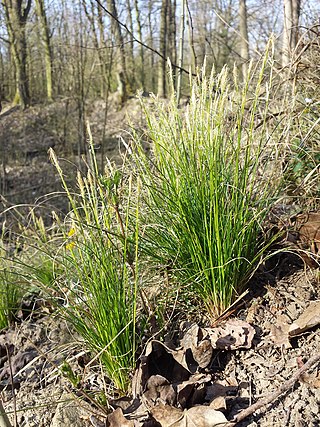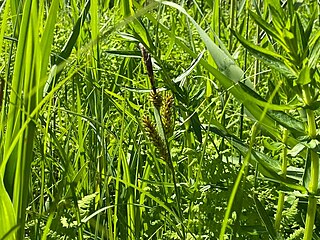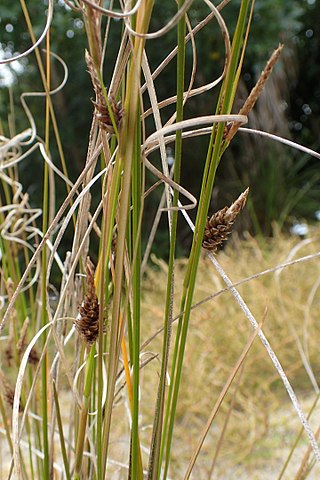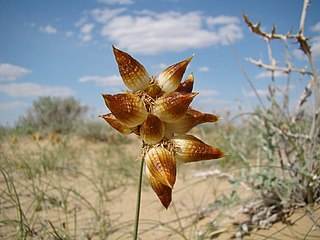
The Cyperaceae are a family of graminoid (grass-like), monocotyledonous flowering plants known as sedges. The family is large; botanists have described some 5,500 known species in about 90 genera – the largest being the "true sedges", with over 2,000 species.

Gahnia grandis is a tussock-forming perennial plant found in southeastern mainland Australia and Tasmania.

Carex pilulifera, the pill sedge, is a European species of sedge found in acid heaths, woods and grassland from Macaronesia to Scandinavia. It grows up to 30 cm (12 in) tall, with 2–4 female spikes and 1 male spike in an inflorescence. These stalks bend as the seeds ripen, and the seeds are collected and dispersed by ants of the species Myrmica ruginodis.

Carex bigelowii is a species of sedge known by the common names Bigelow's sedge, Gwanmo sedge, and stiff sedge. It has an Arctic–alpine distribution in Eurasia and North America, and grows up to 50 centimetres (20 in) tall in a variety of habitats.

Carex inops is a species of sedge known as long-stolon sedge and western oak sedge. It is native to northern North America, where it occurs throughout the southern half of Canada and the western and central United States.

Carex lacustris, known as lake sedge, is a tufted grass-like perennial of the sedge family (Cyperaceae), native to southern Canada and the northern United States. C. lacustris us an herbaceous surface-piercing plant that grows in water up to 50 cm (1.6 ft) deep, and grows 50–150 cm (1.6–4.9 ft) tall. It grows well in marshes and swampy woods of the boreal forest, along river and lake shores, in ditches, marshes, swamps, and other wetland habitat. It grows on muck, sedge peat, wet sand or silt, in filtered or full sunlight.

Carex archeri, known as Archer's sedge, is a species of sedge in the genus Carex, endemic to south-eastern Australia.
Carex arctogena is a member of the sedge family (Cyperaceae) which grows in high alpine areas. It is one of the few "bipolar" species; it has populations in Greenland, Scandinavia, Russia, Canada and southern South America. Plants in the far north and south appear to be genetically identical, having taken advantage of a similar niches on opposite ends of the globe.

Carex elongata, the elongated sedge, is a species of flowering plant in the family Cyperaceae, native to Europe, the Caucasus, western Siberia, Kazakhstan, and the Altai. It occurs in boggy woodland and wet meadows, where it forms dense tussocks up to about 1 m tall.

Carex alba, called the small white sedge, white-flowered sedge or just white sedge, is a species of sedge in the family Cyperaceae. It is typically found in temperate forests of Eurasia, from the Pyrenees to the Russian Far East. It is the main host plant for the woodland brown butterfly, Lopinga achine.

Carex rugulosa, also known as the thick-nerve sedge or the slender-culm thick-nerve sedge, is a tussock-forming perennial in the family Cyperaceae. It is native to the eastern parts of Asia.

Carex breviscapa is a tussock-forming perennial in the family Cyperaceae. It is native to eastern parts of the south east Asia and north eastern Australia

Carex litorosa, commonly known as sea sedge, is a tussock-forming species of perennial sedge in the family Cyperaceae. It is native to New Zealand.
Carex helferi is a tussock-forming species of perennial sedge in the family Cyperaceae. It is native to parts of South East Asia.
Carex interrupta is a tussock-forming species of perennial sedge in the family Cyperaceae. It is native to south eastern parts of Canada and north eastern parts of the United States.
Carex krauseorum, commonly known as Krause's sedge, is a tussock-forming species of perennial sedge in the family Cyperaceae. It is native to subarctic areas of Greenland, Alaska, northern Canada and Russia.

Carex physodes is a species of true sedge, native to southern Russia, the northern Caucasus, Central Asia, Iran, Afghanistan, Pakistan, and Xinjiang in China. It is a spring ephemeral.
Carex cephalotes, also known as wire-head sedge, is a tussock-forming species of perennial sedge in the family Cyperaceae. It is native to south eastern Australia and New Zealand.

Carex dickinsii, also known as Dickins' sedge or chao xian tai cao in pinyin, is a tussock-forming species of perennial sedge in the family Cyperaceae. It is native to parts of Japan, Taiwan and south-eastern China.

Carex adelostoma is a tussock-forming species of perennial sedge in the family Cyperaceae. It is native to the subarctic areas, including Scandinavia, Russia, Canada, and Alaska. A common name is circumpolar sedge.
















